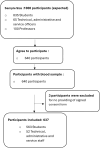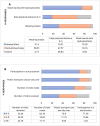Serological survey in a university community after the fourth wave of COVID-19 in Senegal
- PMID: 39570844
- PMCID: PMC11581233
- DOI: 10.1371/journal.pone.0298509
Serological survey in a university community after the fourth wave of COVID-19 in Senegal
Abstract
A cross-sectional survey was conducted at Polytechnic High School (PHS) to assess the spread of COVID-19 infection among students and staff. A random cluster sampling was conducted between May 19 and August 18, 2022, after the fourth wave of COVID-19 in Senegal. IgM and IgG SARS-CoV-2 antibodies were screened using WANTAI SARS-CoV-2 ELISA assays. Seroprevalence and descriptive statistics were calculated, and associations between seropositivity and different factors were determined using logistic regression. A total of 637 participants were recruited and the median age was 21 years [18-63]. 62.0% of the participants were female, and 36.89% were male, with a male-to-female ratio = 0.59. The overall IgG and IgM seroprevalence were 92% and 6.91% respectively. Among those who tested positive for IgM, 6.75% were also positive for IgG, and 0.15% were negative for IgG. Interestingly, 6.90% of participants tested negative for both IgM and IgG. We found a higher IgM seroprevalence in men than women (9.4% vs. 5.6%) and a lower IgM seroprevalence in (18-25) age group compared to (55-65) years. We revealed a significant difference according to IgG seroprevalence among participants who declared fatigue symptoms [92.06% (95% CI: 89.96-94.16)] compared to those who did not [80.39% (95% CI: 77.31-83.47)], p = 0.0027. IgM seropositivity was found to be associated with Body Mass Index (BMI) categories (O.R. 0.238, p = 0.043), ethnic group (O.R. 0.723, p = 0.046), and marital status (O.R. 2.399, p = 0.021). Additionally, IgG seropositivity was linked to vaccination status (O.R. 4.741, p < 0.001). Our study found that most students and staff at PHS were exposed to SARS-CoV-2, confirming the virus's circulation at the time of the survey. We also identified differences in individual susceptibility that need further clarification. Our results highlight the importance of seroepidemiological surveys to assess the true impact of the COVID-19 pandemic in a community and to monitor variations in antibody response.
Copyright: © 2024 THIAM et al. This is an open access article distributed under the terms of the Creative Commons Attribution License, which permits unrestricted use, distribution, and reproduction in any medium, provided the original author and source are credited.
Conflict of interest statement
The authors have declared that no competing interests exist.
Figures



References
-
- WHO Director-General’s opening remarks at the media briefing on COVID19 -March 2020.
-
- https://www.worldometers.info/coronavirus/ (accessed November 12, 2023).
MeSH terms
Substances
LinkOut - more resources
Full Text Sources
Medical
Miscellaneous

